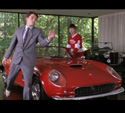|
Butt Reactor posted:No joy on the link, try again? The Buffalo News has recently put up a paywall and their sites are generally a huge pile of poo poo now, but this link *might* work and I assume it is what AWSEFT meant to post: http://www.buffalonews.com/apps/pbcs.dll/article?AID=/20130606/CITYANDREGION/130609441/1010 edit: Newspaper piracy: The Buffalo News posted:WASHINGTON – Sen. Charles E. Schumer today urged the Federal Aviation Administration to bolster its oversight of regional airlines in wake of a recent Buffalo News report that federal aviation officials warned Colgan Air executives about safety problems six months before the crash of the airline’s Flight 3407 in Clarence in 2009, but failed to follow up on that warning.
|
|
|
|

|
| # ? May 15, 2024 10:59 |
|
The FAA is in bed with the airlines, news at 11. I've heard stories that RAH is having the same problem with the Q400's that Colgon had. They Q400 is apparently a bit of a hanger queen and since RAH has no real experience with it they're having a hell of a time keeping them flying. They also have a limited cadre of experienced instructors so their standards department is still learning the airplane while it's out on the line flying. Hindsight is only 20/20 if you bother to look. This is one of the things that really pisses me off about the FAA. An airline can have some SERIOUS safety issues and basically get a slap on the wrist from the feds, but they will hit the people who actually work the line with massive sometimes career altering penalties for even the most minor of infractions. It's at the point where pilots are reluctant to self disclose problems they've had in an effort to stay under the FAA radar. I know a number of pilots who recommend NOT filing a NASA form due to the fact that pretty much any action can be considered "Deliberate or intentional" if the FAA wants it to.
|
|
|
|
|
KodiakRS posted:I know a number of pilots who recommend NOT filing a NASA form due to the fact that pretty much any action can be considered "Deliberate or intentional" if the FAA wants it to. Thank god for ASAP.
|
|
|
|
babyeatingpsychopath posted:This is pretty sweet. I use fltplan.com's mobile app, but this lets me pre-load stuff instead of using their somewhat confusing interface.
|
|
|
|
Schumer's been trying so hard and making it his personal quest to look like a hero since Colgan 3407 to avenge all those lives lost at the hands of those dastardly regional pilots who can't fly worth a drat*. How does it work behind the scenes in what sounds like a "good ol' boy system"? Will the FAA even give him the time of day? (*The "dastardly pilots, can't fly worth a drat" comment isn't my opinion at all. It's the stereotype presented by Sully and Schumer to back the ATP law used sarcastically here. The man makes my skin crawl, so I'd get a bit of schadenfreude if Huerta just goes "Pfft" and stuffs it in the shredder.) CBJSprague24 fucked around with this message at 01:27 on Jun 8, 2013 |
|
|
|
All done with sim and ground training, next week will be a whole week of flying the 206  wee wee
|
|
|
|
Colonel k posted this in the ultralight thread in DIY but I figure some of you guys might get a kick out of it. http://vimeo.com/32121344 Some pretty crazy flying going on.
|
|
|
|
Slaughter if you ever make it down to SoCal hit me up.
|
|
|
|
DNova posted:The Buffalo News has recently put up a paywall and their sites are generally a huge pile of poo poo now, but this link *might* work and I assume it is what AWSEFT meant to post: http://www.buffalonews.com/apps/pbcs.dll/article?AID=/20130606/CITYANDREGION/130609441/1010 Try this one. Its a hard hitting article about the culture Colgan had and how the FAA "intervened". You can't possibly think the airlines aren't in bed with the FAA after reading this. :alert: In case you hit the paywall, text at the bottom. KodiakRS posted:The FAA is in bed with the airlines, news at 11. Buffalo News posted:Colgan warned by FAA about safety prior to 3407 crash AWSEFT fucked around with this message at 22:03 on Jun 9, 2013 |
|
|
|
AWSEFT posted:Nope even worse. Does anyone know what the article was referring to when it said the FO "misprogrammed an important switch"? I was under the impression that the only thing the FO did during the accident sequence that involved a switch was to retract the flaps for undetermined reasons.
|
|
|
|
They are talking about the switch you turn on in icing conditions that adds 20kts or so to stall speeds.
|
|
|
This reminds me of some of the things said in Congress post ValuJetCongress posted:We want to make absolutely sure that we don't just make cosmetic changes, but real changes and effective changes that solve the problems that exist. Congress posted:The FAA has only recently discovered the extent of the problems at ValuJet. That being the case, then the question arises: where has the FAA been all this time? Why didn't the FAA's regular inspection program uncover these problems? Why didn't the special 120-day inspection program uncover these problems? Why did it take a crash, 110 deaths, and an intense 30-day inspection and intense media and Congressional scrutiny to uncover these problems? Congress posted:We need somehow to strike a balance to make sure that we don't over-regulate the aviation industry in this country so that we end up with just one or two large airlines and no others, because then we will force the price of air travel up so much that we would force millions of Americans back onto our already overcrowded and much less-safe highways.
|
|
|
|
|
Golly gee, I see the word "training" quite a bit in that article. I have a friend who flew for Colgan on the Q400 for a short period of time and, while I never really got into details with him, liked it so much that he quit, told me "Don't go to the airlines." and came home to do more instructing. Fortunately for him, he found a corporate flying job not long after, though it sounds like he's not too much happier. quote:We need somehow to strike a balance to make sure that we don't over-regulate the aviation industry in this country so that we end up with just one or two large airlines and no others, because then we will force the price of air travel up so much that we would force millions of Americans back onto our already overcrowded and much less-safe highways. Heh. This happened anyway. The same government didn't over-regulate, but did allow three mega-mergers which pared the Big Six into a Big Three plus Southwest, which ate AirTran up for something to do. Oh, and Midwest and Frontier merged and the whole thing's now owned by a regional airline. 
CBJSprague24 fucked around with this message at 06:17 on Jun 10, 2013 |
|
|
|
CBJSprague24 posted:
He should not have joined a crap regional. I am one month shy from my first year in my regional, and, brutal first year pay aside, I have had a positive experience. Training was excellent, the company is diligent, and the pilot group has been great so far.
|
|
|
|
CBJSprague24 posted:Oh, and Midwest and Frontier merged and the whole thing's now owned by a regional airline. They didn't merge, our dumb ceo bought the two airlines thinking combining two failed business models into one would be a winner  Good by profit sharing checks, hello Frontier pilot group that forgets who bought who. Animal posted:He should not have joined a crap regional. I am one month shy from my first year in my regional, and, brutal first year pay aside, I have had a positive experience. Training was excellent, the company is diligent, and the pilot group has been great so far. This, even at Chautauqua they have a sense of how rare it is not to have a crash in company history, and while there have been close calls, they seem to value safety over the dollar. Ferris Bueller fucked around with this message at 23:12 on Jun 10, 2013 |
|
|
|
Any leads on pilot jobs in NC or FL? I've been searching for 2 years without any luck.
|
|
|
|
AWSEFT posted:Any leads on pilot jobs in NC or FL? I've seen a few flight instructor jobs pop up in FL over the last few months, but I'm guessing you're looking for something slight better than "flying piston single with foreign student trying to kill me".
|
|
|
|
azflyboy posted:I've seen a few flight instructor jobs pop up in FL over the last few months, but I'm guessing you're looking for something slight better than "flying piston single with foreign student trying to kill me". Indeed. Figured with this kind of time a new job would be easy. Ha, can't get a call from anyone.
|
|
|
|
azflyboy posted:I've seen a few flight instructor jobs pop up in FL over the last few months, but I'm guessing you're looking for something slight better than "flying piston single with foreign student trying to kill me". Florida flight schools also prefer you to check the box for "Willing to live in my own car, which will be parked at the FBO, and take all the students flying at the rear end-crack weird times of day."
|
|
|
|
So spin entries are scary. My respect for the CFI in this thread (at least I believe that's where that maneuver comes into play) has doubled.
|
|
|
|
Shavnir posted:So spin entries are scary. My respect for the CFI in this thread (at least I believe that's where that maneuver comes into play) has doubled. Spins are fun as poo poo once you understand them. I won't go entering them intentionally just for kicks or anything, but in Canada you are required to demonstrate a recovery from an instructor-induced spin during PPL training and induce one yourself an recover for CPL. Most fun I had during flight training, aside from the first solo! Respect that poo poo, don't fear it.
|
|
|
|
Spins were the best part of my training. Although seeing nothing but ground through the windshield is a little bit unnerving.
|
|
|
|
Solo spins for my CFI was the most fun I've had during my training
|
|
|
|
Another vote for "spins are awesome" here.
|
|
|
|
Flying backwards (or being suspended in one place) is more fun than spinning. I did that on a windy December day in a 152. Slow flight, into the wind, cue up the "truck backing up" noise. Unicom posted:Spins were the best part of my training. Although seeing nothing but ground through the windshield is a little bit unnerving. My first CFI was supposed to demonstrate a stall to imminent and, in his own words, "got a bit overzealous". The next thing I knew, we were pointed straight down, looking at a sewage treatment plant about a mile below us.
|
|
|
|
The more I read about 3407's crash, the more I think they just massively failed at a go around. They put the flaps to a takeoff oriented position (I don't know the specifics), pushed up the throttle to 75% and kept raising the nose. I think it's an example of expectations and complacency that really did them in. Also, a related note.... going... going... and gone. https://www.youtube.com/watch?v=vtlS0sxFlHk
|
|
|
DNova posted:Another vote for "spins are awesome" here. Oh yeah Baby. The most fun you can (legally) have with an airplane without wearing a chute. During my CFI training we pretty much rolled a 172 doing spins. My instructor would take the entry to a certain point and then yell "recover" somewhere in the incipient spin. At one point he managed to stop the incipient spin when we were more or less inverted and I just recovered by keeping the nose pitched waaaaaaay down and rolling the rest of the way out. It certainly wouldn't have won any aerobatic competitions but I still consider it a "roll." One of the most enlightening things about spin training was when my instructor had me do a simulated base-final overshoot with a sloppy increase in bank and increase in back pressure to compensate. It was a pretty dramatic demonstration of how quickly things can get out of hand and just how much altitude you'd lose in the recovery. I think every student pilot should have the opportunity to go through that just to see what it's like and how quickly you run out of AOA in a 45+ degree turn at low speed.
|
|
|
|
|
xaarman posted:The more I read about 3407's crash, the more I think they just massively failed at a go around. They put the flaps to a takeoff oriented position (I don't know the specifics), pushed up the throttle to 75% and kept raising the nose. I think it's an example of expectations and complacency that really did them in. Is 75% throttle ever appropriate for a go around in that plane? Also thats an amazing video
|
|
|
|
xaarman posted:The more I read about 3407's crash, the more I think they just massively failed at a go around. They put the flaps to a takeoff oriented position (I don't know the specifics), pushed up the throttle to 75% and kept raising the nose. I think it's an example of expectations and complacency that really did them in. They were not attempting a go around. They were on approach. The causes of 3407 are at this point quite well known.
|
|
|
|
DNova posted:They were not attempting a go around. They were on approach. The causes of 3407 are at this point quite well known. Ok reading the report http://www.ntsb.gov/doclib/reports/2010/aar1001.pdf
|
|
|
|
Has anyone else received one of those unsolicited "Ultimate Aviation DVD Series" DVDs in the mail, for which they later attempt to bill you? I think it's a shady practice, and I'm trying to figure out who shared my mailing address with them. I know they didn't get it from the FAA database, since the FAA doesn't even have this address. I suspect it's either AOPA or Aviation Consumer since they are the only ones I've given this address, but they both deny it. Anyone else have any ideas?
|
|
|
|
One of the things I hate about the aviation community is all the spam. gently caress you AOPA.
|
|
|
|
KodiakRS posted:One of the most enlightening things about spin training was when my instructor had me do a simulated base-final overshoot with a sloppy increase in bank and increase in back pressure to compensate. It was a pretty dramatic demonstration of how quickly things can get out of hand and just how much altitude you'd lose in the recovery. I think every student pilot should have the opportunity to go through that just to see what it's like and how quickly you run out of AOA in a 45+ degree turn at low speed. Yup. My simulated was an overshoot, straight out. We entered the stall so gently, we were 20 nose up, 1500fpm descent, no buffeting, and no loss of aileron authority. Nose down, full power, wait for positive rate, flaps up. Only 200' loss, but if that had happened on climbout, there only would have been 200'. Positive rate would have been racing with terrain; hopefully we can react to REAL EPs as fast as we did during checkrides.
|
|
|
|
hobbesmaster posted:Is 75% throttle ever appropriate for a go around in that plane? Nope, but I've been tired and thought I pushed the throttle up more than I actually did. DNova posted:They were not attempting a go around. They were on approach. The causes of 3407 are at this point quite well known. I get that they stalled it into the ground... but if you're tired, flying with a crew you think you know, power pushed up, flaps in a TO position and trying to climb, it's quite an aggressive position.
|
|
|
|
Wasn't he on the left seat with less than 200 hours on type?
|
|
|
|
Animal posted:Wasn't he on the left seat with less than 200 hours on type? Yes. Bonus incompetence: NTSB posted:22 Colgan could not explain the discrepancy between the captain’s total number of hours on the Q400 (111 hours) and his flight time during the 90 days that preceded the accident (116 hours). There is no record of the captain flying an airplane other than the Q400 during the 90 days before the accident.
|
|
|
|
Just worked solar impulse for the last hour and a half on his way east out of st. Louis. Holy hell that thing is slooooow. The guy flying it is very nice though.
|
|
|
|
fknlo posted:Just worked solar impulse for the last hour and a half on his way east out of st. Louis. Holy hell that thing is slooooow. The guy flying it is very nice though. 43 mph... even a glider goes faster!
|
|
|
|
Animal posted:43 mph... even a glider goes faster! He was doing 26kts. I think he started to pick it as he climbed to 7000 to get better radar coverage.
|
|
|
|

|
| # ? May 15, 2024 10:59 |
|
I am enjoying my new job although there is a lot of time sitting around in the hotel, so if I can find a way to make the best of it (work out, play video games) I think I will be really drat happy here. I've got maybe 6 hours in the C206 now, did a bunch of landings and approaches today, it is the most nose heavy airplane I have ever flown but it isn't too tough to land nicely, you just have to flare it until your arms feel like they're going to fall off and they're in terrible pain. Some guys use the electric trim in the flare I guess and put it all the way back but that worries me in case you need to go around that you'd be at risk of trim stalling it unless you push forward really hard. I'd rather just muscle it. As a side note, I really don't like electric trim, but my trainer is forcing me to use it because it's new and I need to be proficient in everything in the airplane, and I guess he thinks the more I use it the more I'll get used to it. I don't like it because I don't know how much it's moving the trim wheel and I feel really "disconnected" from the trim and find it tough to get just the right setting. Grasping the trim wheel is so tangible and you can make such fine corrections. Also, developing a scan for glass is taking a bit of time although my approaches were OK but at times I'd be +-120 ft or so on altitude because I was messing with a checklist or something.
|
|
|


























